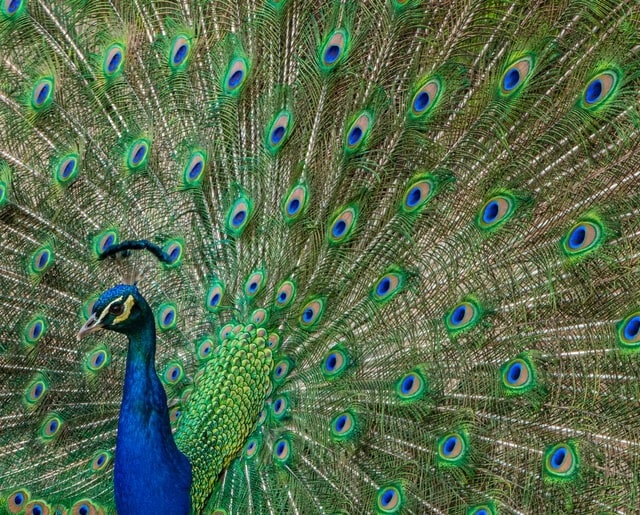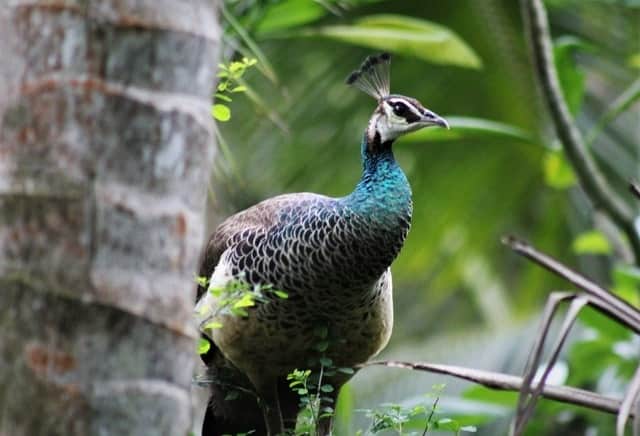Peacock is the term most people use for both male and female peafowl. The correct terms, however, are ‘peacock’ for the males, and ‘peahen’ for the females. Both of which are peafowl, which is the correct term for this species.
Once you know the differences between male and female peafowls, there’s no mistaking which is which. Male peacocks are the ones with the large, impressive, tail feather displays, while females are a lot blander.
Here’s a closer look at the difference between male and female peafowl with pictures (using the most common type of the Indian or Blue Peafowl):
Table of Contents
A Peacock - Male Peafowl

A Peahen - Female Peafowl

Colors
As you can see from the pictures, the most obvious difference between the females and males are their colors and markings.
Males are nothing short of striking. They have bright blue bodies, with green, blue, gold, and other hues in their tail feathers.
Females, on the other hand, have white, a greyish tone, and some darker shades on their bodies. They do have some green/blue on their necks, but nothing as striking as the males.
Tails
You can’t talk about peacocks without mentioning their tails. The males are best known for fanning out their large blue and green tail feathers with the distinctive ‘eye’ markings.
Their tails can be as tall as 2 meters when fanned out and make for a pretty long train when not erected.
It plays a major role in their courtship rituals. It’s believed the male with the largest and most colorful tails will get the females!
Females also have tails, but they’re much smaller and are the same grey and pale brown color as their bodies. They tend to fan out their tails when they feel threatened.
Related - Female peahens do spread their tail feathers, but not in the same way as peacocks.
Heads and Crests
Male and female peafowls have similar shaped heads and both have crests (those tufts of feathers) on the top of their heads.
Peacocks have dark green/black and white markings on their faces and a small bunch of blue crest feathers.
Peahens typically have white faces with some brown markings on the top. They have brown crests, around the same size and shape as the males.
Legs and Spurs
The interesting thing about peafowl is that both males and females have spurs sticking out on the back of their legs just above their foot. Their spurs are very different though.
Peacocks have tougher, pointier spurs, and they won’t hesitate to use them in a fight. Just like roosters, they can do some serious damage with their spurs.
Peahens’ spurs are much blunter than a peacock’s, and sometimes they don’t have any at.
Size
As with most large fowl, peacocks are a lot larger than peahens. Males are typically in the 10-13 lbs range, while females are closer to 7-9 lbs.
When standing all and fanning out their feathers, peacocks can be as tall and long as 7 feet (2 meters). Peahens are closer to 3.2 feet (1 meter).
Behavior
For the most part, both peahens and peacocks spend their days foraging for things to eat and wandering around.
The major differences revolve around their roles of peacocks being the protector of their flock, and peahens having all of the paternal responsibilities.
Then there is the mating display that peacocks are best-known for. They spread their tail feathers out so they literally can’t be missed, and it’s believed that the male with the largest and most impressive tail display will attract the peahens.
Why Are Male Peacocks Prettier?
The males are the most colorful and prettiest in most (not all) bird species. It’s believed that there are a number of reasons for this:
Evolution/Mating - Charles Darwin developed much of the theory in this book The Origin of Species that supports the idea that the most colorful males survive through natural selection as they are most likely to mate.
This is because females are more attracted to the most colorful, and in the case of peacocks, most impressive tail displays. So, over time the male chicks become more colorful.
Survival - It’s important that female birds are able to avoid predators. They are not as adept at fighting, and they have to look after their chicks.
Therefore, the females are typically colors that enable them to blend into the background, and the males are brighter to attract the attention of predators and defend the females.
Territory - Males also fight over territory and often the most colorful male will be able to claim territory and have the backing of the female peafowl. Peacocks also fan out their feathers when they feel threatened, with the larger display being more intimidating.
Related - You can find our more about how far peacock roam here.
Are White Peacocks Male or Female?
You have to understand that all peacocks are males, and the female peafowls are called peahens.
Therefore, if you’re asking if a white peacock is male, then it is a ”yes” as it’s a peacock. If you’re asking if all white peafowls are female, the answer is “no”.
White peafowl are a color mutation of the Indian Blue Peafowl. They’re pretty rare and can be either males or females.
It’s important to note that they are not albinos. They do not have red eyes or suffer from the health conditions often related to being albino.
Their color is determined by a color pigment missing. They can be found in the wild, but are much more commonly obtained from private breeders.
How to Tell If a Baby Peafowl Is Male or Female
For the first few months, it’s hard to sex a peafowl. Breeders and other bird specialists are often able to tell by physically inspecting them, but it’s not easy.
It becomes easier after a couple of months when the bird starts to develop their tail feathers. Peacocks start to develop their long, colorful tail feathers, while peahens develop brownish, shorter feathers.
In Summary
There is no mistaking male and female peafowl. From a couple of months of age when they start to develop their tail feathers, you’ll notice vastly different physical characteristics.
It’s more important to understand that the species is called peafowl. Peacocks are the males, and peahens are the females.
Peacocks are the ones that have bright colored tails with the eye pattern, while the peahens are much blander in appearance.
Resources
Image credits - Header photo by Max S., Peacock by mana5280, and peahen by kanchana Amilani on Unsplash




